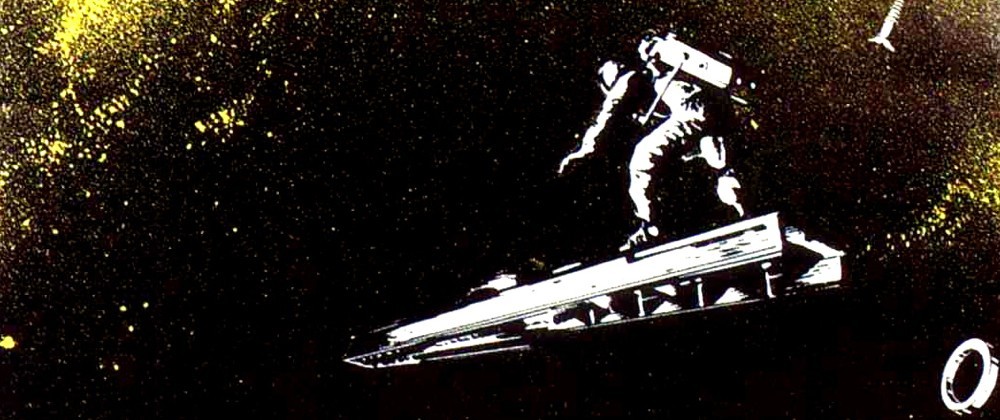Dark Star is the movie every kid in film school hopes to make. It was made for a term project between 1970 and 1973: Cheap yet ambitious, offbeat yet identifiable, and…not really much good at all when judged as a professional wide-release movie, but no one really does that because of the magnitude of the achievement, and the stature of the people involved.
Dark Star was the brainchild of two men, who would go on to define popular genre filmmaking for decades afterwards: Horror legend John Carpenter (who gets that title despite also making some of his era’s greatest sci-fi and action movies) and Dan O’Bannon, who gave the world ideas as varied as zombies who say “Braaaains”, the computer displays in Star Wars and, of course, so much of what we remember about Alien.
This is why we’re beginning Alien Week here at Lewton Bus by discussing Dark Star: Half a decade before Ridley Scott and seven screen greats turned O’Bannon’s ideas into a classic, those ideas were very much on display; unformed, and filtered through the another young master’s eye.
The premise of Dark Star is a kind of missing link between Alien and its most obvious antecedent, 2001: O’Bannon was fascinated by the film’s vision of life in space, but he pointed out that if you were actually living that life, you wouldn’t feel the same sense of epic majesty. Heywood Floyd starts his story taking a business trip and calling his family, Dave Bowman and Frank Poole spend most of their time exercising and eating, or doing routine maintenance – mundane activities, fantastical to contemporary audiences but still mundane.

Cool in 1968, but today I’m just wondering what he did to the brightness settings on his tablet.
O’Bannon, taking inspiration from a variety of sources – everywhere from Bradbury’s classic grim SF tales to Beckett’s masterpiece Waiting For Godot to his own life and friends – to create a vision of a science-fictional world, where things would be just as boring as the real world. Dark Star is the story of five-man crew on the titular spaceship, sent on a decades-long mission in space, nuking planets from orbit (heh heh) to make them suitable for colonization in thousands of years. Grim work, worse than meaningless, and done with no supervision, aid, or contact with the wider world, but boring the whole crew out of their minds.
Life in space is meant to resemble the ennui of having a dumb job in college: The crew (laid-back and hairy to a man) only really seem to be themselves when they’re listening to music, or goofing off in their dorm room – pardon me, sleeping quarters. There’s a clear connection to the hardscrabble, lower-class crew of the Nostromo – in fact, the crew of the Dark Star might be even more worthlessly apathetic, if anything. John Hurt’s Kane never spent weeks on end in the ship’s control tower for no reason other than ennui, and Brett and Parker never fought over a laser gun just because the other wanted it.
In Alien, the banality of space was used to both foreshadow and offset the horrific onslaught of the titular monster, but the crew of the Dark Star barely even have the excitement of having to fight for their lives. The only dead crewmember was killed in a dumb malfunction, weeks before the movie starts, and the only alien is a literal spray-painted beach ball with claws, about as non-threatening as a mischievous catlike monster can be.

Imagine this as the proto-Xenomorph in Prometheus. Go on, do it, it’s truer than what we got.
This lack of texture is probably the film’s greatest failing: The direction shows Carpenter was a master of tone from the womb, being able to switch in a split second from relaxed camaraderie to procedural peril or angry tension (Thanks in no small part to Carpenter’s signature droning electronic score), but beyond having next to no story, there’s also next to no sense of drive for the narrative. Carpenter makes things feel like they should be tense, or exciting, or scary, but what we actually see doesn’t back it up – until a sequence at the end, when the dead-serious design and deadpan performance works to advance a comedic twist on HAL’s rebellion into something seriously funny and thoughtful, so much so I actually won’t spoil it.
As in Alien, most of the Dark Star’s crew don’t survive the movie. O’Bannon’s talent for murdering his characters like a gimmick serial killer is quite evident, but this massacre is missing a sense of pacing: Before that crackerjack ending, there’s a solid hour full of footage that Carpenter and O’Bannon shot on sufferance, to pad out their 45-minute student film to an 80-minute feature after they got a distribution deal. The new content is pretty easy to spot if you’re looking – it’s done almost entirely solo with the character played by O’Bannon himself, the short-tempered Sgt. Pinback – but the upside to the film’s sluggish, nearly homogenous structure is that the new content fits in pretty seamlessly.
Alien: Covenant has had an interesting marketing campaign, invoking everything from Hieronymus Bosch to John Denver, but the mixture of old-school claustrophobic horror, philosophical musings and mid-century Americana (Compare “Take Me Home, Country Roads” to Carpenter’s original composition for Dark Star, the melancholy and cleverly science-fictional “Benson, Arizona”) all call to mind Dark Star, maybe even more so than it does the 1979 original.








